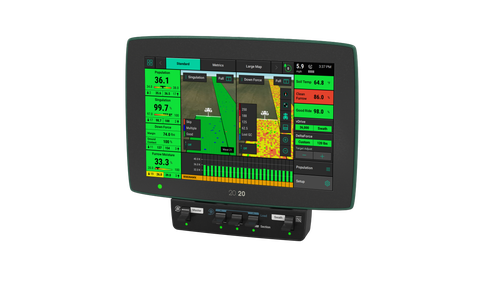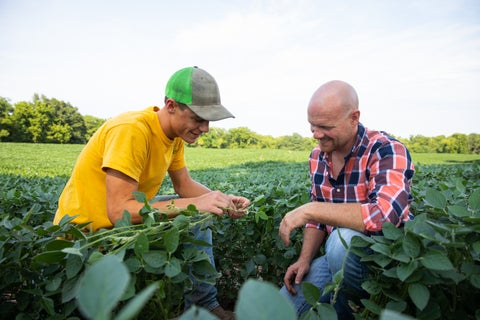Key Points
- Objective: To evaluate yield and economics of harvesting multiple corn hybrids at earlier and later harvest grain moisture levels over the course of three years. The first goal of this study is to determine if “phantom” yield loss occurs at lower grain moisture harvests. The second goal is to determine the most economical harvest moisture level for both on-farm and commercial drying methods.
- Highest Yield: On average over two years, 26% moisture corn has resulted in the highest yield of 261.8 Bu/A. As moisture level decreases, yield decreases, showing the presence of phantom yield loss.
- Drying Methods: Commercially drying corn at the lowest moisture level (around 16%) reaps the most economic benefits, whereas drying corn on-farm at the highest moisture level (around 26%) is best. Between the two drying options, on-farm drying proves more economical, saving up to $65/A on average.
Phantom Yield Loss Study: 2023-2024
We’ve gathered two years of data in this intensive 3-year study to understand phantom yield loss and how it affects yields and economics for both commercial and on-farm drying.
Over the last two years, we studied five corn hybrids at earlier and later harvest intervals from 30% down to 15% grain moisture levels to determine if higher moisture grain at harvest offers higher yields, and if so, whether a “phantom” yield loss occurs at lower grain moistures.
Phantom Yield Loss and Why It Happens
What is phantom yield loss? It’s when some of your corn’s weight vanishes as it dries in the field. This weight loss is “invisible,” hence the name.
Phantom yield loss might occur due to:
- Wind damage and/or stalk lodging
- Dry matter loss from respiration
- Ear rots leading to kernel damage
- Insect damage leading to kernel damage
- Increased butt shelling at corn head
- Increased fines, cracked dry kernels
Phantom Yield Loss Study Results
In 2023, we saw proof of phantom yield loss. In 2024, again, we confirmed phantom yield loss.
This table shows the data from the last two seasons (2023 and 2024) of Yield/A for various moisture levels. As you can see, as moisture level declines, corn yield decreases, meaning some yield is lost the drier the corn gets.
On-Farm vs Commercial Drying
So is the answer to simply harvest wet corn? Not necessarily, because as we know, drying that corn comes at a cost.
That’s why we evaluated the same corn moisture levels (26%, 24%, 19% and 16%) to determine the most economical moisture level, considering the cost of both commercial and on-farm drying methods.
Commercial Drying
First, we calculated the cost of commercial drying at our local grain terminal. Commercial shrink was calculated at 1.4% at 14% grain moisture.
This table shows the average net return for all harvest moistures in a commercial grain elevator delivery at harvest. The lowest moisture level, 16%, saw the highest overall net return for all 5 corn hybrids. All other moisture levels saw economic deficits, with 24% moisture levels resulting in the highest loss of -$33.23/A averaging across two years.
On-Farm Drying
Next, we calculated the costs of on-farm drying. Using our GSI Q214 continuous flow dryer and propane gas, drying charges averaged $0.017/moisture point/bushel over two years.
The results are completely inverted compared to commercial drying. The highest moisture level corn, 26%, saw the highest overall net return for all 5 corn hybrids. As corn dried in the field, net losses increased, with 16% moisture corn resulting in the highest loss of -$29.60/A averaged over two years.
The More Economical Method: On-Farm Drying
Comparing commercial vs on-farm drying, on-farm drying proved more economical overall.
This table reveals the economic advantage of on-farm drying over commercial drying and shrink charges. On-farm drying resulted in savings of up to $65.96/A on average over two years compared to commercial costs.
That’s why for us here at the PTI farm, based on this two-year data, a 24-26% harvest moisture level is the sweet spot for the most economical drying using our on-farm system.
Additional Costs to Consider
While it’s hard to quantify them with a dollar amount, there are a few other costs to consider in this study and your own evaluations:
- Hours of operation: On-farm drying allows for 24/7 “open hours” for drying and storage, compared to commercial facilities that close at night. In this study, on-farm drying saw higher harvest efficiency as we were able to dry and store through the night.
- Patronage dividends: Patronage dividends are profit distributions paid by a co-operative to growers based on how much they use the co-op’s services, and should be factored into the total costs if applicable. For example, using the data from this study, if a patronage dividend of $7.18/A was paid to the grower, the total savings of the grain storage facility would come to +$64/A.
In-Depth Study Videos
InsidePTI
2023 Phantom Yield Loss Study ‣ Corn
Study Details
Study data collected 2023-2024 at the PTI Farm in Pontiac, IL.
| Planting Date | 2023 - April 27 2024 - May 20th | Rotation | CAB (2023) CAC (2024) |
| Row Width | 30" | Population | 36K |
| Corn Prices | 2023 - $5.31 2024 - $4.08 | Hybrid | 2023 - DKC 61-40SS, 11-35TRE, 66-06VT2P, GH 02K39 2024 - DKC 61-40SS, 111-35TRE, 66-06VT2P, GH 02K39 |

